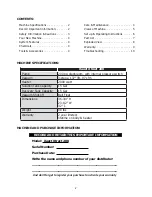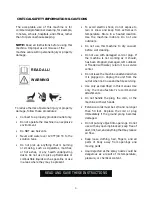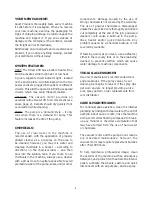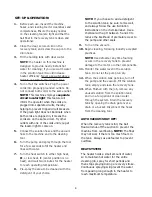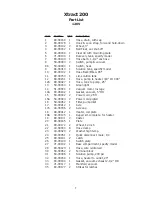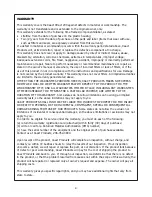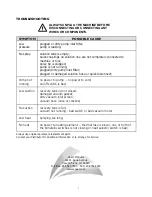
6
1. Before each use, inspect the machine,
hoses, and cleaning tool for cleanliness and
completeness. Ensure the spray nozzles
on the cleaning tool are tight and that the
ball fl oat in the recovery tank is clean and
operational.
2. Close the clear, screw-on lid on the
recovery tank, and screw the cap onto the
drain hose.
3. Fill the holding tank with clear water.
NOTE: the heater on this machine is
designed to provide nearly instant hot
water for cleaning; if you use warm water
in the solution tank it would increase
heater effi ciency. Never use water above
120 ºF or 49 ºC in the solution tank.
4. Turn off all the switches. Plug the power
cords into properly grounded outlets. Do
not connect both cords to the same outlet.
NOTE: This machine employs a separate
circuit locator light; this feature will
inform the operator when the cords are
plugged into separate circuits, thereby
helping to prevent tripped circuit breakers.
If the green light does not illuminate when
both cords are plugged in, it means the
cords are on the same circuit. Try other
outlets with one of the cords until you get
the locator light to come on.
5. Connect the solution hose and the vacuum
hose to the machine and to the cleaning
tool.
6. Turn the pump and spray through the tool
for a few seconds to fi ll the heater and
lines with water.
7. Turn the heat switch to either high heat,
II, or low heat, I (center position is no
heat), and wait two minutes for the heater
to reach operating temperature.
8. Pre-spray the area to be cleaned with the
detergent of your choice.
NOTE:
If you choose to add a detergent
to the solution tank, be sure to mix well,
and always follow the use & dilution
instructions on the chemical label. Use a
chemical with a pH between 5 and 10 to
reduce the likelihood of premature wear to
the pump and other seals.
9. Turn on the vacuum.
10. Begin cleaning, following industry accepted
practices.
NOTE:
Use defoamer any time foaming
occurs in the recovery tank to prevent
damage to the motor or other components.
11. Monitor the water level in the solution
tank. Do not let the pump run dry.
12. When the solution tank gets low, turn off
the pump and the vacuum, fi ll the solution
tank, empty and clean the recovery tank.
13. When fi nished with the job, remove any
unused solution from the solution tank,
and run a few gallons of clean water
through the system. Drain the recovery
tank by opening the drain gate over a
drain or a bucket. Disconnect the hoses
from the cleaning tool.
AUTO VACUUM SHUT OFF:
When the recovery tank is full, the ball
fl oat will shut-off the suction to prevent the
machine from overfl owing. NOTE: The fl oat
may not work if there is too much foam in
the tank. Always use defoamer to prevent
overfl ow.
HEAT SYSTEM:
The heater holds a small amount of water,
so to maintain hot water for the entire
cleaning job, spray for short periods and
then stop spraying during a recovery stroke.
Continuous spraying will prevent the water
from pausing long enough in the heater to
reach maximum temperature.
SET-UP & OPERATION:


